|
|
LUNAR ECLIPSES:
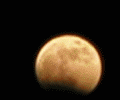
Lunar eclipse video.
(Image courtesy of Greg Sellek, Madison, Wisconsin, USA).
What causes lunar eclipses?
Whenever and where ever there is light there are shadows and this includes all heavenly bodies. Since the Sun is the
source of light all shadows are opposite the Sun in our solar system. If we cheat a little and assume that outer space
is gray and not completely black, we can see the Earth's and Moon's shadows.
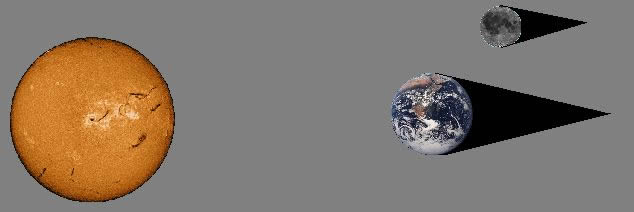
Top view of shadows.
A lunar eclipse is caused by the Moon passing through the Earth's shadow. Now, if you read the section above on the
phases of the Moon, you might think that a lunar eclipse would occur every time there was a Full Moon (since the Moon
is on the shadow side of the Earth during Full Moons). However, the orbits of the Earth around the Sun and the Moon
around the Earth are not on the same plane. If we assume that Earth's orbit around the Sun is horizontal, then the
Moon's orbit around the Earth would be tilted by about 5 degrees. From a spaceship flying along side the solar system
during a Full Moon, the two orbits would look something like this (the red line shows Earth's orbit
and the green line shows the Moon's orbit):

Side view of orbits during Full Moon.
From a spaceship flying along side the solar system during a New Moon, the orbits would look
something like this:

Side view of orbits during New Moon.
OK. Now the problem is that we never get lunar eclipses. Fortunately, for those of us who like to see lunar
eclipses, the Moon rotates around the Earth faster than the Earth Rotates around the Sun. So there are times when
the Moon is directly behind the Earth (creating a Lunar eclipse) and other times when the Moon is
directly between the Earth and the Sun (creating a Solar eclipse). By the way, lunar eclipses occur
about twice a year!
The animation below shows the Moon rotating around the Earth while the Earth rotates around the Sun. Only when the
Earth is at points A or C can eclipses occur. At no other time is it possible for the
Moon to be directly behind the Earth or directly between the Earth and the Sun.
Simple enough. However, shadows have 2 parts: the umbra and the penumbra. The umbra is the center and darkest part of
the shadow. While the penumbra is the outer and lighter part of the shadow (the penumbra is so light that we hardly
notice it on Earth). The parts of the Earth's shadow are shown below. The picture below also shows how to figure out
where the umbra and penumbra are (note the lines from the Sun).
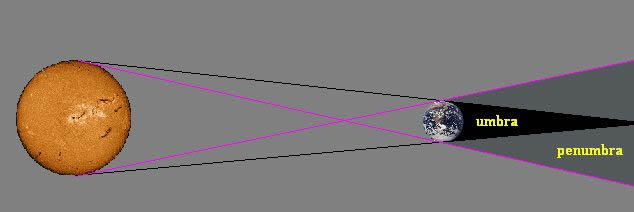
The umbra and penumbra parts of a shadow.
Since lunar eclipses are caused by the Moon passing through the Earth's shadow and since there are 2 parts of a
shadow, there are 3 types of lunar eclipses:
-
A penumbral eclipse occurs when the Moon passes through the penumbral part of Earth's shadow. A penumbra
eclipse does not cause a noticeable darkening of the Moon's surface. About 35% of all lunar eclipses are
penumbral.
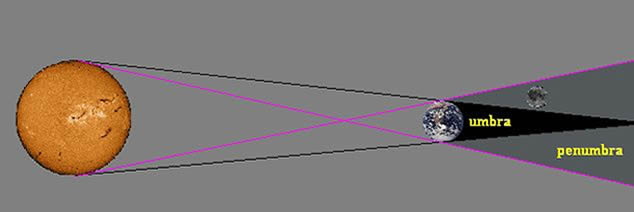
A penumbral eclipse.

A timelapse photo of the March 15, 2006 penumbral eclipse.
(Photo courtesy of Tricia Johnson).
-
A total (or umbral) eclipse occurs when the Moon passes through the umbral part of Earth's shadow. About
35% of all lunar eclipses are umbral.
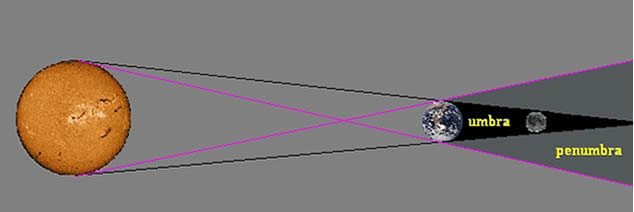
A total (or umbral) eclipse.
The Moon doesn't completely disappear as it passes through the umbral part of the shadow because of the refraction of
sunlight by the Earth's atmosphere. In other words, the umbra is dark, but not completely black (you may have noticed
that your shadow is not completely black either). As a result the Moon will glow with a coppery-red hue. However,
since clouds and dust in the atmosphere block some of the light, the glow will vary from one eclipse to the next.
-
A partial eclipse occurs when the Moon passes through some of the umbral part and some of the penumbral
part of the Earth's shadow. About 30% of all eclipses are partial.
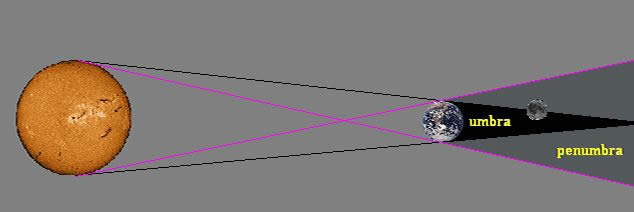
A partial eclipse.
To summarize, lunar eclipses are caused by the Moon passing through the Earth's shadow.
Also, lunar eclipses can only occur during a Full Moon!
For more eclipse information visit:
|







